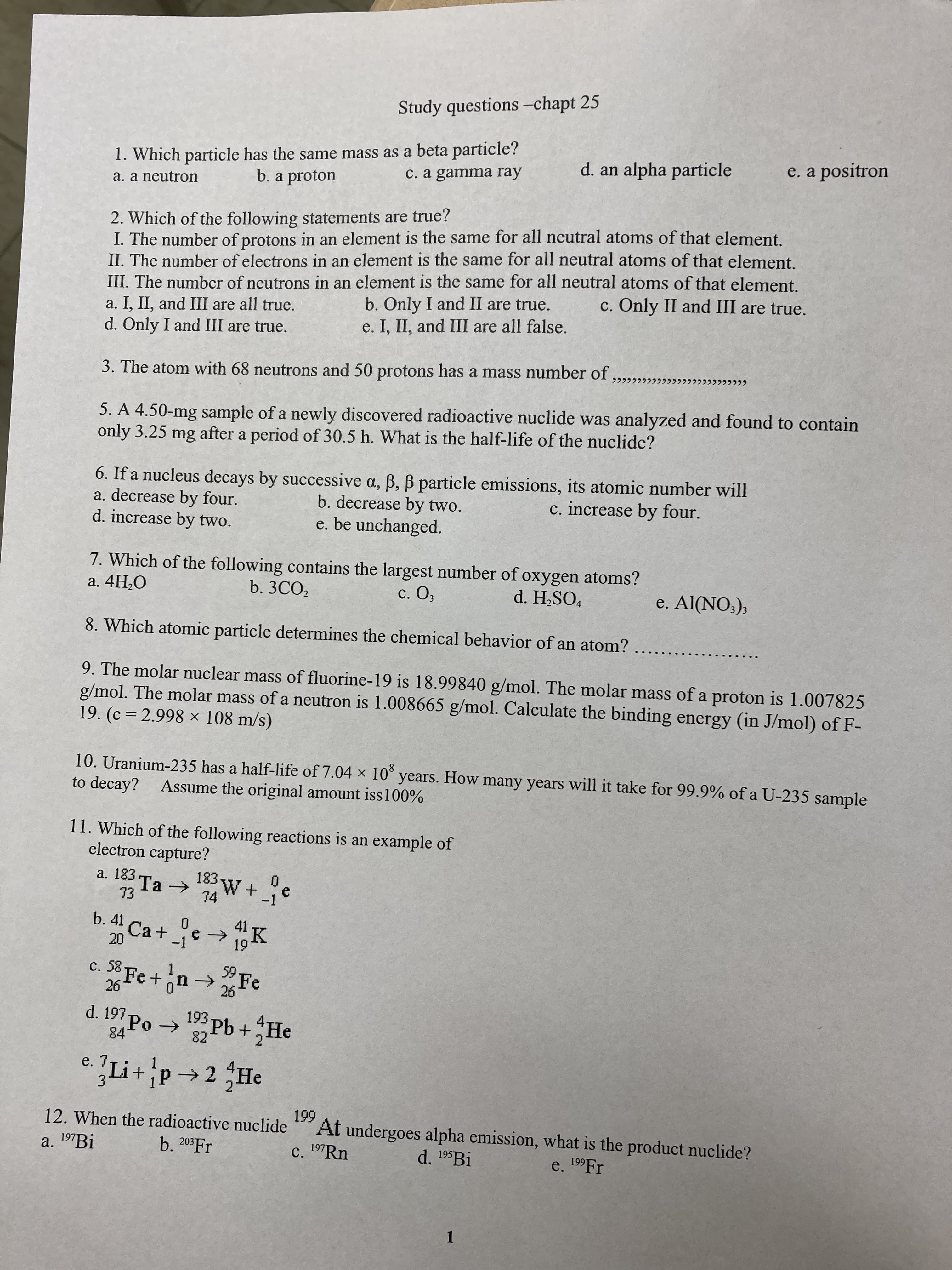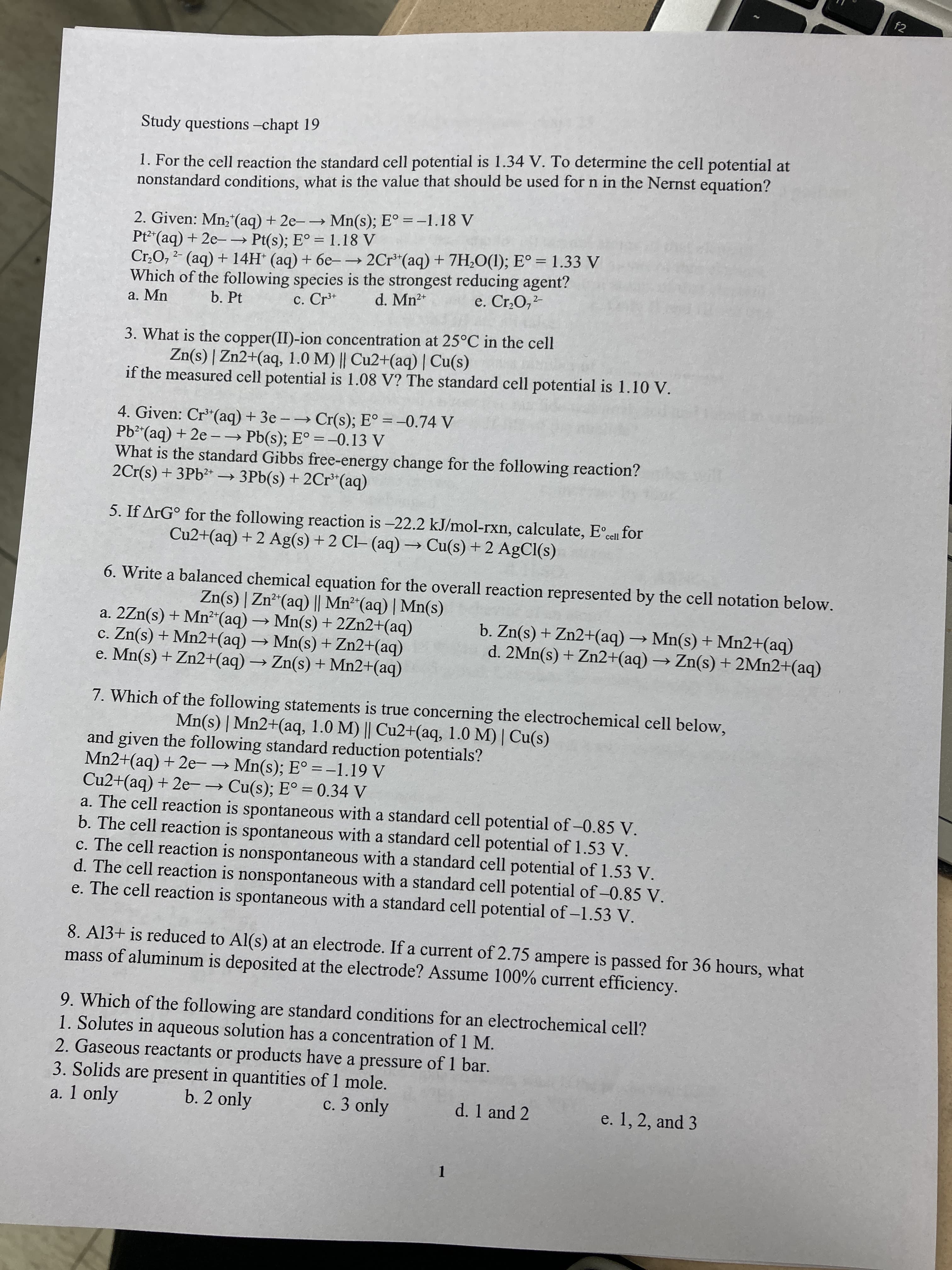Chemistry: An Atoms First Approach
2nd Edition
ISBN:9781305079243
Author:Steven S. Zumdahl, Susan A. Zumdahl
Publisher:Steven S. Zumdahl, Susan A. Zumdahl
Chapter17: Electrochemistry
Section: Chapter Questions
Problem 160MP
Related questions
Question

Transcribed Image Text:Study questions -chapt 25
1. Which particle has the same mass as a beta particle?
b. a proton
d. an alpha particle
e. a positron
c. a gamma ray
a. a neutron
2. Which of the following statements are true?
I. The number of protons in an element is the same for all neutral atoms of that element.
II. The number of electrons in an element is the same for all neutral atoms of that element.
III. The number of neutrons in an element is the same for all neutral atoms of that element.
a. I, II, and III are all true.
d. Only I and III are true.
c. Only II and III are true.
b. Only I and II are true.
e. I, II, and III are all false.
3. The atom with 68 neutrons and 50 protons has a mass number of
5. A 4.50-mg sample of a newly discovered radioactive nuclide was analyzed and found to contain
only 3.25
mg
after a period of 30.5 h. What is the half-life of the nuclide?
a. decrease by four.
d. increase by two.
6. If a nucleus decays by successive a, B, B particle emissions, its atomic number will
b. decrease by two.
e. be unchanged.
c. increase by four.
7. Which of the following contains the largest number of oxygen atoms?
a. 4H,O
b. 3CO,
c. O,
d. H,SO,
e. Al(NO:);
8. Which atomic particle determines the chemical behavior of an atom?
9. The molar nuclear mass of fluorine-19 is 18.99840 g/mol. The molar mass of a proton is 1.007825
g/mol. The molar mass of a neutron is 1.008665 g/mol. Calculate the binding energy (in J/mol) of F-
19. (c = 2.998 × 108 m/s)
10. Uranium-235 has a half-life of 7.04 x 10° years. How many years will it take for 99.9% of a U-235 sample
to decay? Assume the original amount iss100%
11. Which of the following reactions is an example of
electron capture?
a. 183
Ta >
EL
b. 41
74
-1
Ca +
-1
K
c. 58
Fe+1
9.
Fe
d. 197
84
Pb+
82
9.
4.
2.
Li+p2 He
4.
3.
12. When the radioactive nuclide
At undergoes alpha emission, what is the product nuclide?
c. 197RN
a. 197B.
b. 203 Fr
d. 195Bİ
e. 19F.

Transcribed Image Text:f2
Study questions -chapt 19
1. For the cell reaction the standard cell potential is 1.34 V. To determine the cell potential at
nonstandard conditions, what is the value that should be used for n in the Nernst equation?
2. Given: Mn; (aq) + 2e- Mn(s); E° = –1.18 V
Pt2*(aq) + 2e-→ Pt(s); E° = 1.18 V
Cr,O, 2- (aq) + 14H (aq) + 6e-→ 2Cr*(aq) + 7H;O(1); E° = 1.33 V
Which of the following species is the strongest reducing agent?
a. Mn
d. Mn2+
e. Cr,O,-
b. Pt
c. Cr*
3. What is the copper(II)-ion concentration at 25°C in the cell
Zn(s) | Zn2+(aq, 1.0 M) || Cu2+(aq) | Cu(s)
if the measured cell potential is 1.08 V? The standard cell potential is 1.10 V.
4. Given: Cr*(aq) + 3e -Cr(s); E° = -0.74 V
Pb² (aq) + 2e -→ Pb(s); E° =-0.13 V
What is the standard Gibbs free-energy change for the following reaction?
2Cr(s) + 3Pb2* → 3Pb(s) + 2Cr*(aq)
5. If ArG° for the following reaction is -22.2 kJ/mol-rxn, calculate, Ecell for
Cu2+(aq) + 2 Ag(s)+ 2 Cl- (aq) – Cu(s) +2 AgCl(s)
6. Write a balanced chemical equation for the overall reaction represented by the cell notation below.
Zn(s) | Zn*"(aq) || Mn* (aq) | Mn(s)
a. 2Zn(s) + Mn²“(aq) Mn(s) + 2Zn2+(aq)
c. Zn(s) + Mn2+(aq) → Mn(s) + Zn2+(aq)
e. Mn(s) + Zn2+(aq) → Zn(s) + Mn2+(aq)
b. Zn(s) + Zn2+(aq) Mn(s) + Mn2+(aq)
d. 2Mn(s) + Zn2+(aq) → Zn(s) + 2MN2+(aq)
7. Which of the following statements is true concerning the electrochemical cell below,
Mn(s) | Mn2+(aq, 1.0 M) || Cu2+(aq, 1.0 M) | Cu(s)
and given the following standard reduction potentials?
Mn2+(aq) + 2e-→ Mn(s); E° =-1.19 V
Cu2+(aq) + 2e-→ Cu(s); E° = 0.34 V
a. The cell reaction is spontaneous with a standard cell potential of -0.85 V.
b. The cell reaction is spontaneous with a standard cell potential of 1.53 V.
c. The cell reaction is nonspontaneous with a standard cell potential of 1.53 V.
d. The cell reaction is nonspontaneous with a standard cell potential of -0.85 V.
e. The cell reaction is spontaneous with a standard cell potential of -1.53 V.
%3D
%3D
8. A13+ is reduced to Al(s) at an electrode. If a current of 2.75 ampere is passed for 36 hours, what
mass of aluminum is deposited at the electrode? Assume 100% current efficiency.
9. Which of the following are standard conditions for an electrochemical cell?
1. Solutes in aqueous solution has a concentration of 1 M.
2. Gaseous reactants or products have a pressure of 1 bar.
3. Solids are present in quantities of 1 mole.
a. 1 only
b. 2 only
c. 3 only
d. 1 and 2
e. 1, 2, and 3
Expert Solution
This question has been solved!
Explore an expertly crafted, step-by-step solution for a thorough understanding of key concepts.
This is a popular solution!
Trending now
This is a popular solution!
Step by step
Solved in 2 steps with 2 images

Knowledge Booster
Learn more about
Need a deep-dive on the concept behind this application? Look no further. Learn more about this topic, chemistry and related others by exploring similar questions and additional content below.Recommended textbooks for you

Chemistry: An Atoms First Approach
Chemistry
ISBN:
9781305079243
Author:
Steven S. Zumdahl, Susan A. Zumdahl
Publisher:
Cengage Learning


Chemistry
Chemistry
ISBN:
9781305957404
Author:
Steven S. Zumdahl, Susan A. Zumdahl, Donald J. DeCoste
Publisher:
Cengage Learning

Chemistry: An Atoms First Approach
Chemistry
ISBN:
9781305079243
Author:
Steven S. Zumdahl, Susan A. Zumdahl
Publisher:
Cengage Learning


Chemistry
Chemistry
ISBN:
9781305957404
Author:
Steven S. Zumdahl, Susan A. Zumdahl, Donald J. DeCoste
Publisher:
Cengage Learning

Chemistry: The Molecular Science
Chemistry
ISBN:
9781285199047
Author:
John W. Moore, Conrad L. Stanitski
Publisher:
Cengage Learning

Principles of Modern Chemistry
Chemistry
ISBN:
9781305079113
Author:
David W. Oxtoby, H. Pat Gillis, Laurie J. Butler
Publisher:
Cengage Learning

Chemistry: Principles and Reactions
Chemistry
ISBN:
9781305079373
Author:
William L. Masterton, Cecile N. Hurley
Publisher:
Cengage Learning